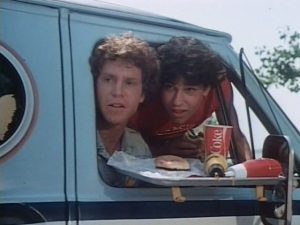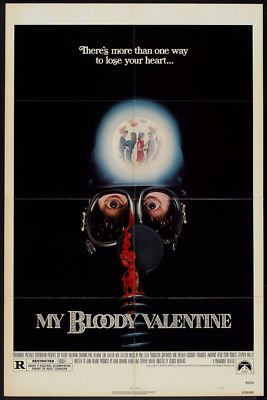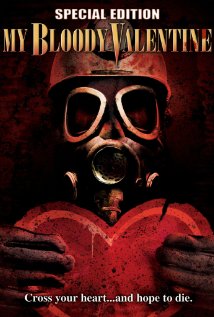Your early producer Bob Presner told me that he met you after seeing a short film you did with your cinematographer Rodney Gibbons called Pizza to Go.
That was our final student film, a 30-minute experimental satirical comedy based on the idea of short attention spans and TV remote controls. Basically, we had someone watching TV and, as it went from channel to channel, the random snippets of shows made up a surreal storyline. We did everything from soap operas to westerns to film noir to detective shows and our own ads for beer. It was a lot of fun and caught the eye of everyone in the industry. I should put it on YouTube!

You should! Now, on the strength of that short, you landed your first feature, Pinball Summer.
That’s right. I was 26 when I did Pinball Summer. Basically, we were all two years out of university. It was Rodney’s first feature as a DOP, Bob Presner’s first as a line producer, and the list goes on and on, from makeup to costumes to hair. You name it, it was everyone’s first feature.
Pinball Summer has several similarities to another Montreal-shot film that came out at almost the same time, Hog Wild. What was the timeline for those particular films?
We were aware of it. Hog Wild was written once the industry [Astral Films –Ed.] realized we were doing Pinball Summer. They started shooting just as we finished. Our suppliers for the film, like the guys who let us use their classic cars, would come to us and tell us there was this other film that’s been asking for the same stuff. I guess imitation is the sincerest form of flattery!
But because we were so young, we were the laughingstock all the smart money went to Hog Wild. They referred to us as the “children’s crusade” and “the amateurs.” Everybody expected that Pinball Summer wasn’t going to get finished, or if it did, that it would be a bomb.
Well, it certainly wasn’t a bomb. I like that Pinball Summer also works as a really interesting time capsule of the late 1970s and early ’80s, with pinball, custom vans, drive-ins and a really laidback feel.
It was sort of the last hurrah of innocent teenagehood, and it has some pretty funny moments. I would have liked to go a little deeper into social issues, but it was my first film and I was just happy to be part of the team. I wasn’t going to lose the opportunity to learn how to make a film, so I decided not to flirt with other issues. Of course by the time I got to My Bloody Valentine, I just said, “I’m sneaking this shit in!”
While Pinball Summer was a hit immediately in the U.S., it seems that My Bloody Valentine owes a large part of its success to home video. When did you get an inkling that interest in My Bloody Valentine was growing?
I started getting regular fan mail in the early 1990s. At first I chalked it up to the fact that it was on video for awhile, and people had seen it. I thought it would blow over, but it just kept going. I started getting fan mail from around the world—Russia, Japan, Australia, England. Some even send memorabilia for me to sign, including one sheets, flyers and publicity photos. It’s gotten to be a ritual, every time I go to my agent, they have a pile of posters to sign.
How often does My Bloody Valentine screen?
Apparently it screens regularly in the States. When Tarantino came out four or five years ago and said it was his favourite film of the era, and put it on the grindhouse circuit with Pinball Summer, that gave it another set of legs. And then there was the remake of course, and now the restored DVD. The phenomenon continues—it’s just amazing.
You went into production and shot the film very fast, in about seven months, right?
My Bloody Valentine was made very quickly because our producers at Cinepix had a deal to deliver it to Paramount in early February so it could be released on Valentines Day. At the time it had one of the largest releases ever—1,200 theatres across North America, which was unheard of. We finished shooting at the end of October or early November.
In those days, post-production was a very lengthy process. Nothing was computerized, everything was done by hand. We had two teams–negative cutters and sound editors–working around the clock to get it done.
Bob Presner told me that your producer at Cinepix, John Dunning, was really pushing you to go over-the-top with gore effects.
One of the things I told the producers right off the top was that I’m not doing a beer commercial—my violence is not beauty shots, it’s ugly and mean and nasty. And wounds hurt. But John was really into experimenting with effects. I remember having to reshoot the scene where Sylvia gets impaled on the shower head, because John didn’t think there was enough blood on her sweater. John was really into doing these cool one-shot effects. Along with our effects guy, Tom Burman, we invented a whole new way of doing mechanical effects. Half this stuff was never done before.
Now, when you sent My Bloody Valentine to the MPAA, they threatened to give it an X rating.
Nobody expected it to get an X, we felt Halloween was just as gory. What differentiated our film from Halloween, of course, is that ours had a much stronger sense of reality. In Halloween, it was mostly done with cuts, but we were doing really strong state-of-the-art effects in single shots, which gave it a much stronger sense of presence. Also, they had just started doing movies in stereo. We had this incredible soundtrack done by Burbank Editorial. Not only were the images in My Bloody Valentine powerful and shocking, but so was the sound. It was the combination of these two elements that basically got the MPAA’s knickers in a serious twist.
So what happened?
We sent a print off to the MPAA and they came back and said “Oh my God!” Now, Paramount can’t release an X-rated movie, in those days an X meant the movie went to about 16 porno houses. So Paramount said we had to do the cuts, and we sent our editor down to L.A. to sit down with the MPAA and work with them.
They basically said, “you have take out one second out of this and three seconds out of that, and 12 frames out of there.” Of course, that was very difficult, because we had done these things in one shot. Now, when you cut the negative in those days, you immediately lost the last frame of the shot and the first frame of the next shot, because the splices in the negative had to be glued together by hand. Also, sound mixing was done on separate 35mm magnetic tracks. We were running 120 of them at the same time, and they had to be resynchronized to match whatever we did.
We brought them the recut film, and the MPAA said it wasn’t good enough. So we take more out and our master sound has to be recut again. All of a sudden we need a new sound effect, so we have people working around the clock trying to create that.
We go back again for the third time, and again they told us to take more stuff out. It got to the point where they were asking us to take out frames that were no longer there, but they thought it was because the sound was so powerful. As a result, the fans who went to see it were disappointed.
Even without the full gore, the cut version of the film built up a notable cult following. How do you account for its success?
My Bloody Valentine has a totally different atmosphere and feel to it it portrayed a gritty universe that was never shown in other horror films and still isn’t. We had these working class subtexts about youth having no future and unemployment. These things were certainly not the domain of slasher films, which basically had interchangeable Barbies and Kens running around getting drunk and being punished for having sex. And that still seems to be the format! Even the new remake of Valentine focuses on that more than anything else. It’s like, “It’s bad to have sex, someone’s gonna kill you for it!”
The film was released on DVD by Lionsgate in 2009 in a version advertised as “uncut.” Is it?
GM:Not entirely–a couple scenes that got cut are just not available. Around 2000, Paramount called me to see if I wanted to a director’s cut and I said I’d love to. Then, a couple of months later, they came back and said the negatives were either lost or unusable. I don’t think Paramount realized that the film would still work for an audience in the future, so they didn’t exactly keep it in the same place as On the Waterfront.
For example. when Hollis walks in and finds Tom and Harriet dead with the giant drill through them, we had a powerful scene where they got killed—-so powerful, that the MPAA just made us take the whole thing out. That’s something that’s lost forever. And for the showerhead scene that we restored, the camera pans up, and the water’s turned on, but it cuts before you get to see Sylvia fully with the blood spraying out of her mouth. That’s because the negative was cut frame by frame for that scene. But at least now people can see what we were trying to achieve.
John Dunning was considering a few different uses for the remaining cut footage he kept. At one point he said he wanted to use it in a sequel, but that obviously never happened. Do you think the present uncut DVD of the film is the best use of that footage?
I think so. I read the sequel scripts, and with all due respect they were all just built around the flashback material. Honestly, I don’t think there was really a sequel in the movie. The aftermath of what happened to these people after the film is best left to the imagination.
What makes Harry Warden such an effective and memorable character?
Harry Warden wasn’t born evil, he was a hardworking guy who went insane when the bosses neglected the people that worked for them, causing a disaster. I really insisted on this subtext. Okay, it’s not exactly a treatise on Das Kapital, but at the same time, that’s who the character is.
Even though you say he wasn’t “born evil,” Harry Warden is just as frightening as slashers that were, like Freddy Krueger and Jason Voorhees.
Almost more frightening, because he’s got a purpose. The others don’t really have a purpose other than violence for violence’s sake—they kill for their entertainment. Harry doesn’t do that—he never stands and watches his work, never rubs his hands in glee as people suffer. There’s no toying.
One great thing about both Pinball Summer and My Bloody Valentine is that they look quite professional, certainly better than many Canadian B-films from the same time.
No matter how small or large the budget, I always tried to make my movies look like movies. They’re always well cut, well framed, look good and have energy. Rodney and I developed that style, and I’ve always done it since then. I’ve been very lucky that way, because that’s how I’ve been able to survive being in Canada all these years.
From My Bloody Valentine you went back to comedy, and never really returned to the horror genre.
After I made My Bloody Valentine, all of a sudden the only job I could get in English Canada was another horror film, which I didn’t want to do. If they had offered me another one as cool as My Bloody Valentine I would have done it, but I don’t want to do something like Halloween III. I did flirt with the iconography of horror later on, but I’ve always felt like I was a filmmaker first, and that I was technically astute and capable enough to make all kinds of movies.
Even though you’ve tried out several different genres, it seems that comedy is your first love, with films like Pinball Summer and Scandale. But despite some very talented actors and directors, English-Canada has never had much luck translating comedy on film.
It’s not because we can’t, it’s because of what I call the “film appreciation course hangover.” Comedy is considered a lesser art form. We’ve chased all our great comic actors and directors away. If you want to carry on doing comedy, you got to go somewhere else. Ivan Reitman makes the first movie that breaks 100 million dollars [Ghostbusters], and what happens to him in Canada? He gets shat on. Instead of people lining him up to give him another one, he’s stuck. Bob Clark made incredibly strong dramas, but he makes Porky’s, which beats all kinds of other records and he becomes a pariah. But is Porky’s really any less intelligent than American Pie?
It’s quite a bit better, in my estimation. But one thing you do have in common with these other directors is that you survived the tax shelter years and kept working when many others could not.


